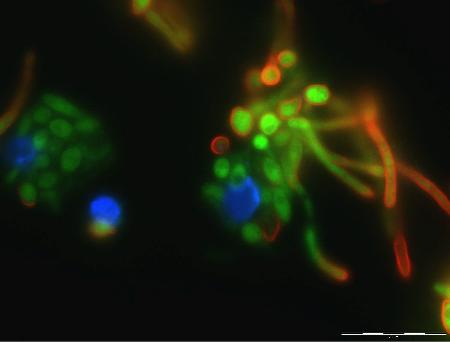Scientists find a new way to protect against lethal fungal infections

Candida albicans (green) is being eaten by a dentritic cell (blue). MFPL/IMBA
For most people, a simple case of thrush or athlete’s foot can be quickly and easily treated using over-the-counter anti-fungal creams and pills. However, even with medication, fungal pathogens can overwhelm a weakened immune system and cause systemic infections – as in people with HIV/AIDS, or organ transplant recipients, for example – posing a severe health risk.
In fact, fungal pathogens have been classified as “hidden killers” and an estimated 1.5 million people around the world die from such systemic infections every year. There is yet no effective medicine available for systemic fungal infections.
Knowing the enemy
When fungal cells enter the body, they stand out from our own cells because they are ‘flagged’ with unique patterns of molecular markers. These ‘pathogen-associated molecular patterns’, or PAMPs for short, are recognised by receptor proteins on cells of the immune system. These receptors then activate signalling molecules triggering a cascade of different immune functions, such as inflammation, aimed at recruiting immune cells to the infected area. Those recruited immune cells will then, for example via the production of highly toxic reactive oxygen species, eliminate fungal pathogens.
“Unleashing” an immune response
Candida albicans is recognized by certain PAMP receptors, called Dectins, and triggers activation of the signalling molecule SYK. The first authors of the study, Gerald Wirnsberger (IMBA) and Florian Zwolanek (MFPL), now discovered that the protein CBL-B acts as a ‘brake’ in this pathway: when CBL-B is present, Dectin and SYK activity are dampened and immune responses are eventually ‘switched off’, but when CBL-B is absent, Dectin/SYK get over-activated and a protective anti-fungal immune responses occur.
Using this knowledge, the two research groups around Josef Penninger (IMBA) and Karl Kuchler (MFPL) – designed an inhibitory peptide to block CBL-B activity and thereby unleash defence mechanisms against invading fungal pathogens. After successfully testing this peptide with lab-grown cells, the peptide was used to treat Candida albicans infected mice. While untreated mice succumbed to the lethal infection, peptide treatment provided complete protection from fungal disease.
Gerald Wirnsberger explains: “This work constitutes a novel paradigm in antifungal therapy – a pharmacological modulation of the host immune response mediated by CBLB. A fundamental understanding of how molecular mechanisms either boost or damp our immune response against Candida albicans will pave the way for a drugs against deadly fungal infections”.
Original publication:
„Inhibition of CBLB protects from lethal Candida albicans sepsis“.
Gerald Wirnsberger, Florian Zwolanek, Tomoko Asaoka, Ivona Kozieradzki, Luigi Tortola, Reiner A Wimmer, Anoop Kavirayani, Friedrich Fresser, Gottfried Baier, Wallace Y Langdon, Fumiyo Ikeda, Karl Kuchler & Josef M Penninger.
Nature Medicine, July 18, 2016. doi: 10.1038/nm.4134.
Press contact:
Ines Méhu-Blantar
IMBA Communications
Dr. Bohrgasse 3, 1030 Vienna, Austria
Tel.: +43 664 808 47 3628
ines.mehu-blantar@imba.oeaw.ac.at
Media Contact
All latest news from the category: Life Sciences and Chemistry
Articles and reports from the Life Sciences and chemistry area deal with applied and basic research into modern biology, chemistry and human medicine.
Valuable information can be found on a range of life sciences fields including bacteriology, biochemistry, bionics, bioinformatics, biophysics, biotechnology, genetics, geobotany, human biology, marine biology, microbiology, molecular biology, cellular biology, zoology, bioinorganic chemistry, microchemistry and environmental chemistry.
Newest articles

Security vulnerability in browser interface
… allows computer access via graphics card. Researchers at Graz University of Technology were successful with three different side-channel attacks on graphics cards via the WebGPU browser interface. The attacks…

A closer look at mechanochemistry
Ferdi Schüth and his team at the Max Planck Institut für Kohlenforschung in Mülheim/Germany have been studying the phenomena of mechanochemistry for several years. But what actually happens at the…

Severe Vulnerabilities Discovered in Software to Protect Internet Routing
A research team from the National Research Center for Applied Cybersecurity ATHENE led by Prof. Dr. Haya Schulmann has uncovered 18 vulnerabilities in crucial software components of Resource Public Key…





















